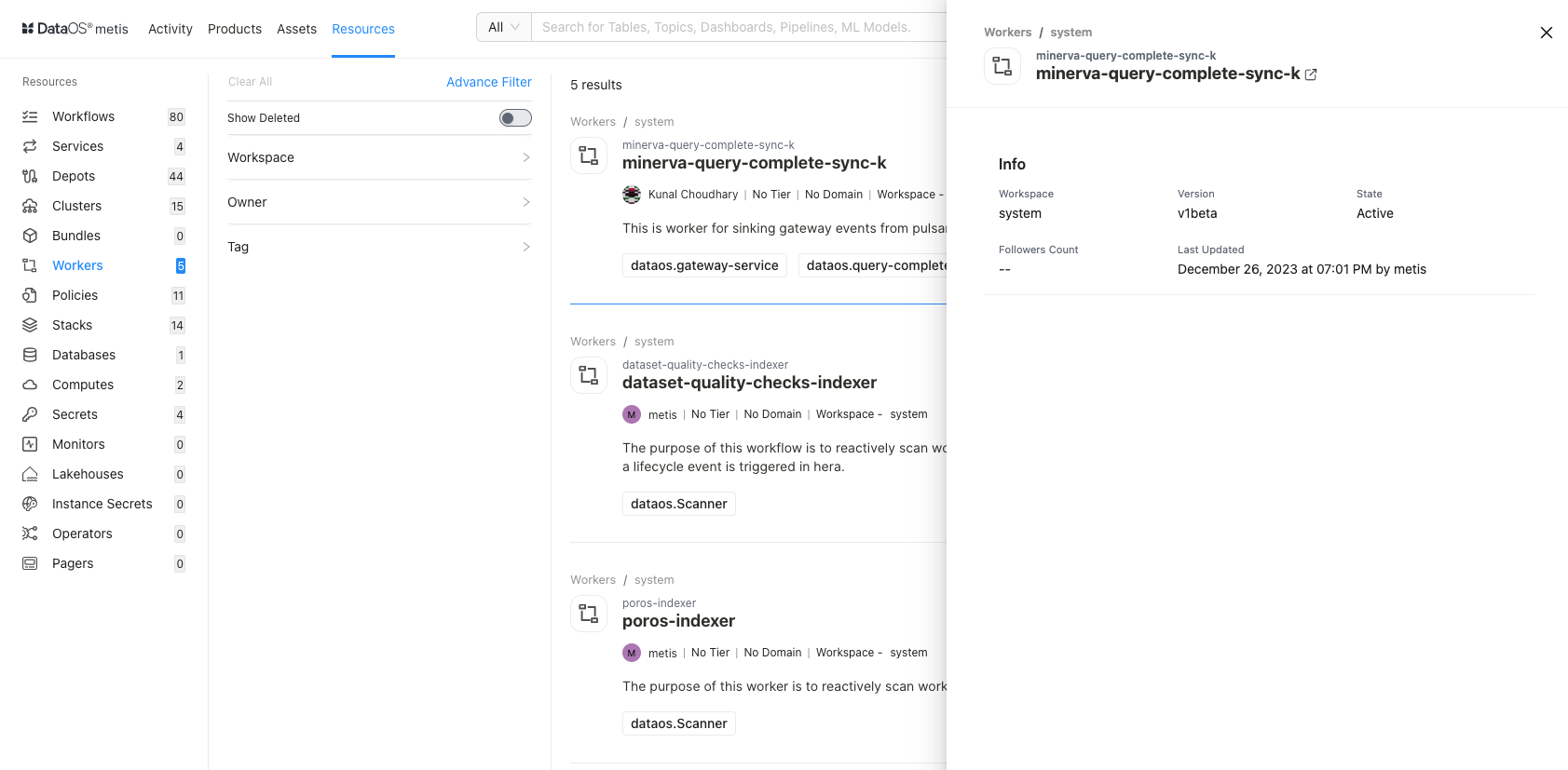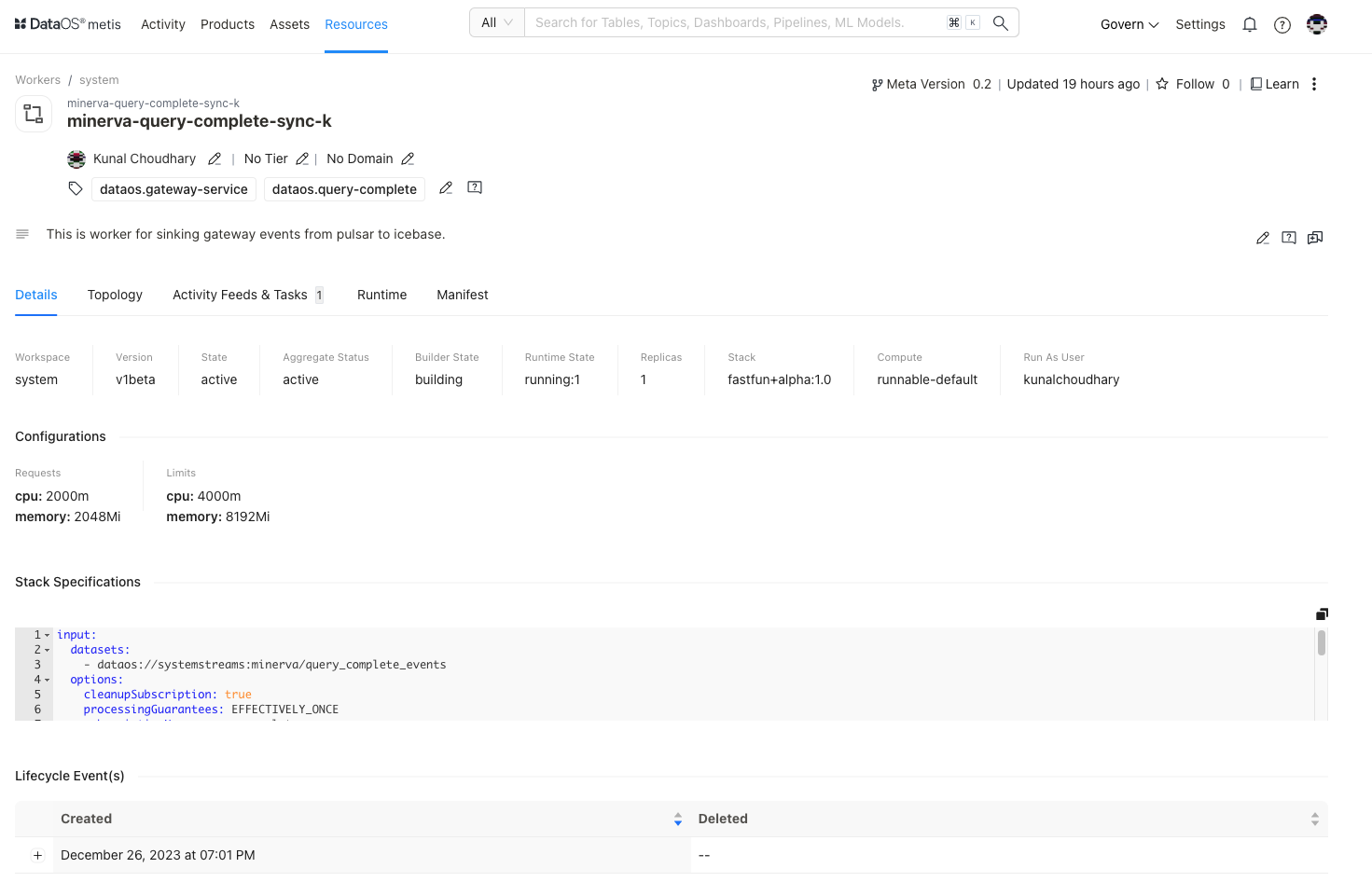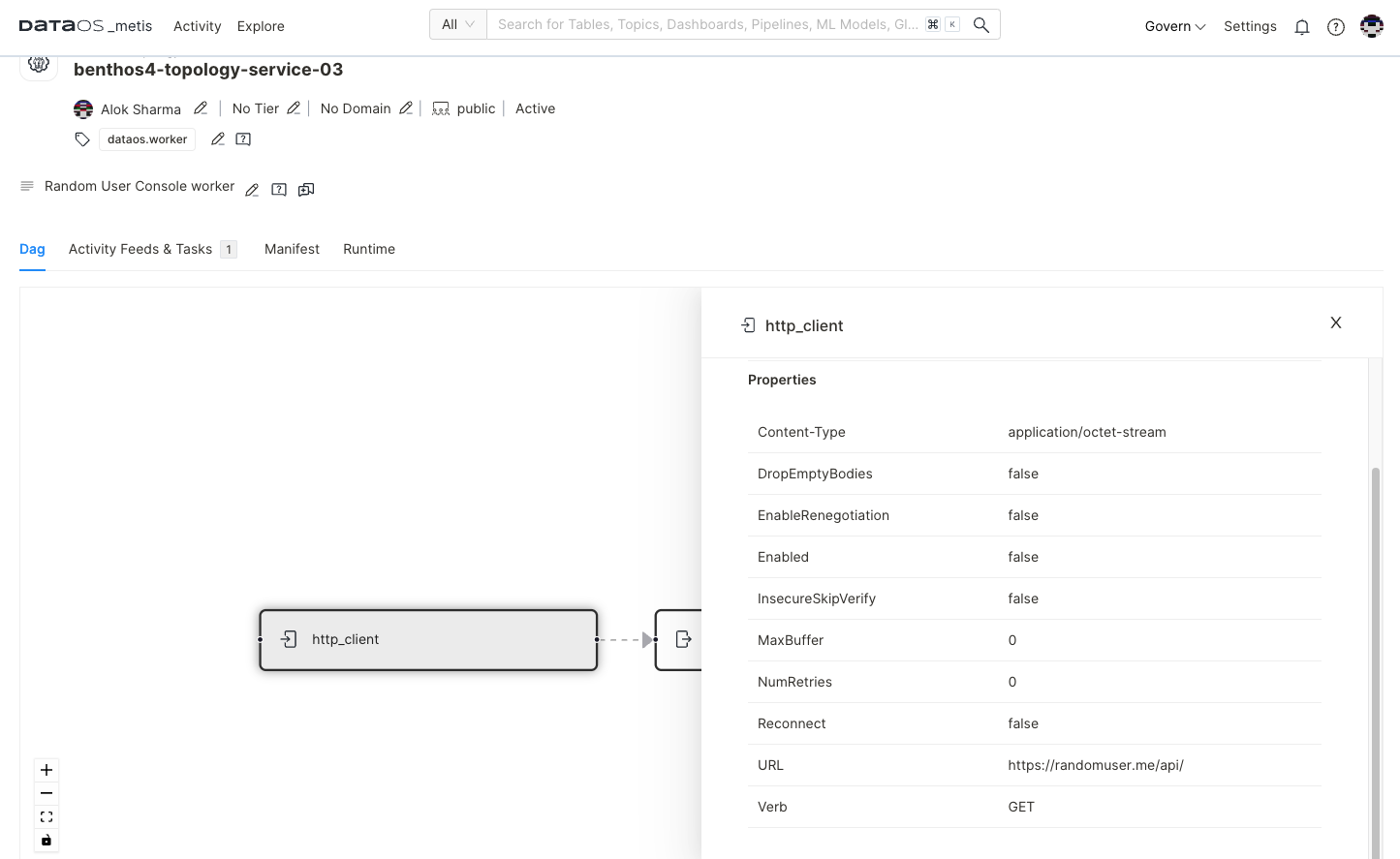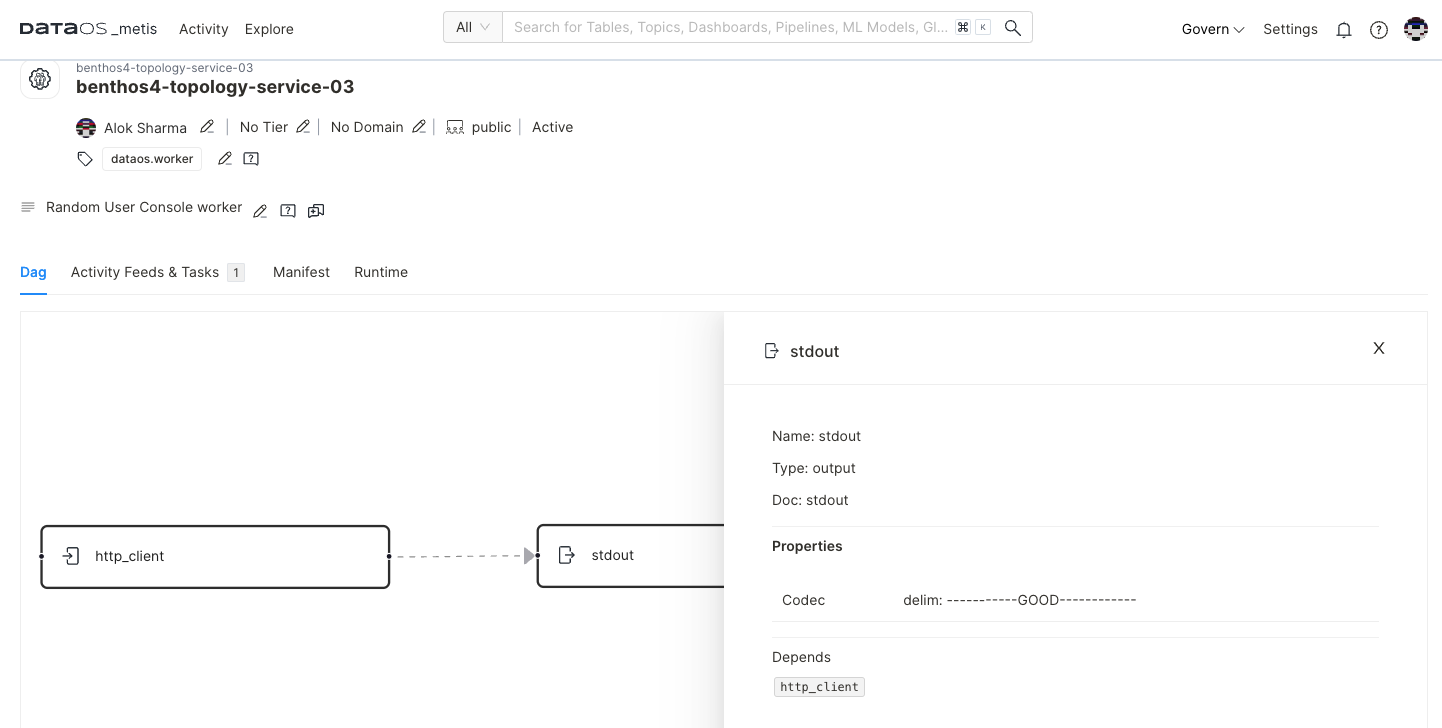Metadata of Workers on Metis UI¶
Metis has integrated "Worker" as a "Resource” type entity for storing metadata related to the long-running process within DataOS to perform specific tasks or computations. On selecting Workers, the following information will appear on the screen:

Filter pane¶
The filter pane allows you to filter the list of Workers on the basis of the following attributes:
| Attribute | Description |
|---|---|
| Advance Filter | Filter Workers using the syntax editor, applying various criteria with 'and/or' conditions for a more refined search. |
| Show Deleted | Set the toggle to list deleted Workers. |
| Workspace | Workspace where the Worker is created, like public or user-specific. |
| Owner | Filter the list based on the user who created the Worker Resource. |
| Tag | Filter the list for tags. |
Result pane¶
Here, Worker resources will be listed. Users have the following options to customize how the list is displayed:
| Option | Description |
|---|---|
| Sorting Order | Choose the Sorting order |
| - Last updated | |
| - Relevance | |
| Sorting Order | Ascending/Descending order. |
Each worker resource in the list will have a Card view that displays the following information for that specific worker:
| Attribute | Description |
|---|---|
| Name | Worker name defined in the resource YAML. |
| Owner | Name of the user who created the Worker. |
| Tier | Tier associated with the importance and criticality of Workers, such as Gold, Silver, etc. |
| Domain | Associated domain, such as Finance, Marketing etc. |
| Workspace | Workspace where the Worker is created like public or user-specific. |
| Description | A description added to the Worker for its purpose. |
Overview pane¶
In the card view, click anywhere except the resource name to get the overview.

This includes the following quick reference information:
| Attribute | Description |
|---|---|
| Name | Name of Workers, clicking on it will open its detail view in the new tab. |
| Workspace | Workspace where Worker is created like public or user-specific. |
| Version | Metadata version. |
| State | Worker state such as Active or Deleted. |
| Followers Count | Count of users who are following this Worker. |
| Last updated | Date and time information when the Worker was last updated. |
Details Page¶
In the Result or Overview pane, click on the name of the Worker to open the Resource Details page, which includes:

Workers Information¶
In addition to the basic Worker's information, the following details and options are provided:
| Attribute | Description |
|---|---|
| Resource Type | Workers |
| Meta Version | Provides information on the latest Meta version. Click to see the version history and corresponding updates. |
| Last updated | Date and time information when the Worker was last updated. |
| Follow | Gives the user an option to follow the Worker to receive updates and view its follower count. |
| Learn | Provides an option to learn more about this specific resource type |
| Delete | Gives the user the option to delete the Worker (click on three dots to access this option). |
| Owner | Allow the user to edit the owner’s name. |
| Tier | Gives the user an option to add/edit the tier information. |
| Domain | Allows the user to add the predefined domain name. |
| Tags | Add/Remove tags/glossary terms/tag groups. |
| Request Tags Update (?) | Request updates in tags and assign users to do it. |
| Description | Allows the user to edit the description. |
| Request Description Update (?) | Request updates in the description and assign users to do it. |
| Tasks | Option to view tasks created. In the side pane, the user will get the option to create a new task. |
| Conversations | View conversations in the side pane. The user will get the option to start a new conversation by clicking on the ‘+’ sign. |
The subsequent tabs will provide you with more detailed information, as explained in the following sections.
Details¶
| Attribute | Description |
|---|---|
| Workspace | Workspace where Worker is created like public or user-specific |
| Version | The specific version or release of the DataOS Worker Resource |
| State | Current state of the Resource such as Active or Deleted. |
| Bundles | List of Bundle Resources containing the Worker |
Topology¶
A Directed Acyclic Graph (DAG) is a conceptual representation of a sequence of activities. For the Worker, this shows the input and processing steps and output.
Clicking on the Input will display the following details in the side pane:

| Attribute | Description |
|---|---|
| Name | Name of the underlying selected entity |
| Type | Type of selected entity such as input, processor, etc. |
| Doc | Details provided in the configuration |
| SQL | SQL statement to transform data |
| Properties | |
| Content-Type | Specifies that the input expects data in the "application/octet-stream" format. |
| DropEmptyBodies | If set to "false," meaning it won't discard responses with empty bodies. |
| EnableRenegotiation | If set to "false," it indicates that renegotiation is disabled for TLS connections. |
| Enabled | If set to "false," it indicates that this input is currently disabled. |
| InsecureSkipVerify | If set to "false," ensures that SSL certificate verification is enabled for secure connections. |
| MaxBuffer | If set to "0," indicating no maximum buffer size for responses. |
| NumRetries | if set to "0," meaning no retries will be attempted for failed requests. |
| Reconnect | If set to "false," it indicates that the input will not automatically reconnect in case of a connection failure. |
| URL | Specifies the URL (https://randomuser.me/api/) to which the GET request is sent. |
| Verb | Specifies the HTTP method used for the request, in this case, "GET." |
Clicking on the Output will display the following details in the side pane:

| Attribute | Description |
|---|---|
| Name | Name of the underlying selected entity |
| Type | Type of selected entity such as input, processor, output etc. |
| Doc | Details provided in the configuration |
| Codec | Refers to a configuration or setting within the stdout output resource, which helps interpret or format the data that is sent to the standard output stream |
| Depends | States dependency if any. In this case, http_client |
Activity Feeds & Tasks¶
This space lists all activities, including tasks and conversations around the specific Worker resource.
Runtime¶
This section provides an overview of the Worker's execution history. It offers a concise summary of past runs, allowing users to quickly access information about the Worker's previous operations and performance.

You can further access:
Pod Details
This option provides information about the Worker resource's underlying pods, including their configuration and status.
Pod Usage
This option will provide insights into how the pods are utilized, including resource consumption and performance metrics.
Pod Logs
Users can access logs generated by the Worker resource's pods, helping to troubleshoot issues and monitor activity.
Pod Manifest
View a YAML configuration file defining the pod's settings and attributes, providing a clear view of its setup.
Manifest¶
This section offers comprehensive information regarding the Worker's manifest. A manifest file, in this context, takes the form of a YAML configuration file. This file serves as the blueprint that defines the configuration settings for various DataOS Resources.